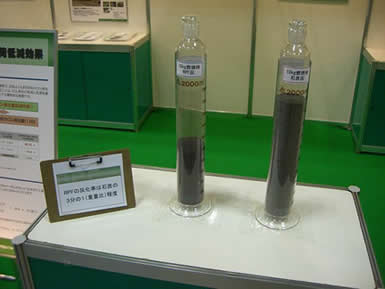Effects of environmental load reduction
RPF’s effect on CO2 reduction
RPF is a high-grade fuel that, when compared to coal (for example, imported steam coal), upon combustion performs at the identical calorific value recovery which results in a 33% reduction in CO2 emissions over coal. The use of RPF as a coal substitute fuel is a very friendly measure for our global environment that has such synergistic effects as reduction in CO2 emissions, saving exhaustible resources, and the prolongation of landfill disposal sites.
Volume of CO2 emissions
of RPF (0.67)
Volume of coal CO2 emissions per unit
of heat (1.00)
And, RPF results in 33% less CO2 emissions than coal at the same calorific value recovery time!!
Table of comparison of carbon dioxide (CO2) emissions (RPF vs coal)
| Fuel utilized | A) Unit calorific value*1)GJ/t |
B) Unit calorific value kcal Conversion 1000/4.18605 *A |
C) Emission coefficient *2) |
D) CO2 emissions per ton | E) CO2 discharge ratio for RPF compared with coal |
|---|---|---|---|---|---|
| New Energy (RPF solid fuel) |
① 25.7 GJ/t | ② 6,139 kcal/kg | ③ 1.5700 t-CO2/t | ④ 1.57 t-CO2/t | ⑨ 67.4 % |
| Imported Steam Coal | ⑤ 25.7 GJ/t | ⑥ 6,139 kcal/kg | ⑦ 0.0247 t-C/GJ | ⑧ 2.33 t-CO2/t | ⑩ 100.0 % |
| Calorific conversion coefficient | 4.18605 | ||||
(Source)
* 1): Unit·Standard calorific value: May 2007, General Energy Statistics Examination Office of the Resource and Energy Agency
“Standard Calorific Value Study Results and Revised Values in Use from 2005 Onward”
* 2): Emission coefficients:
March 2006 Ministry of Economy, Trade and Industry, Ministry of the Environment Ordinance No. 3
“Ministerial ordinance on the calculations of the volume of greenhouse effect gas emissions associated with the business activities of specific emitters”
(Reference)
GJ (Giga Jules) is109 J (Jules).
Calorific conversion is based on the following formula. 1.00000 kcal = 4.18605KJ (definitional equation based on the law of weight and measure)
The volume of CO2 emissions per D) ton of imported steam coal is 0.0247 tC/GJ, but in order for this to convert to t – CO2/GJ it is multiplied by (CO2 molecular weight/C atomic weight) 44/12 = 3.67.
RPF CO2 reduction effect: Explanation
Each circled number corresponds to the number that is written in each cell within the table above.
| ① | From ⑤, RPF has proportionate calorific value to coal so it is configured with the same numbers. |
| ② | ① converts to kcal display. From ①, 25.7GJ/t=25.7×109÷4.18605×10-6=1000×25.7÷4.18605=6139.4→6139kcal/kg. |
| ③ | Quotation from the “Ministerial ordinance on the calculations of the volume of greenhouse effect gas emissions associated with the business activities of specific emitters” March 2006 Ministry of Economy, Trade and Industry, Ministry of the Environment Ordinance No. 3 |
| ④ | Same as ③ |
| ⑤ | From the “Standard Calorific Value Study Results and Revised Values in Use from 2005 Onward” it becomes 25.7MJ/kg but, that is converting units as GJ/t. Energy Statistics Review Administration Office of the Natural Resources and Energy Agency May 2007(GJ=1000×MJ t = 1000×kg. ) |
| ⑥ | From ⑤, it becomes 25.7GJ/t = 25.7×109÷4.18605×10-6 = 1000×25.7÷4.18605 = 6139.4→6139 kcal/kg. |
| ⑦ | Quotation from the “Ministerial ordinance on the calculations of the volume of greenhouse effect gas emissions associated with the business activities of specific emitters” March 2006 Ministry of Economy, Trade and Industry, Ministry of the Environment Ordinance No. 3 |
| ⑧ | From ⑦, 0.0247t-C/GJ represents the number of carbon tons per 1 Gigajoule. For this reason, in order to convert to CO2 per ton, ⑤ x ⑦ x44/12 (molecular weight of CO2/atomic weight of C) = 25.7×0.0247×(44/12) = 2.327→2.33 t – CO2/t. It becomes ⑤ x ⑦ x 44/12 (molecular weight of CO2/atomic weight of C) = 25.7×0.0247 × (44/12) = 2.327→2.33t – CO2/t. ※ The molecular weight of CO2 is the sum of Carbon atomic weight (12) and Oxygen atomic weight (16) × 2. 44=12+2×16=12+32 |
| ⑨ | Simple comparison is possible because ④ and ⑧ are the same unit, that is, the tonnage of CO2 emitted when burning 1 ton. 100× ④ / ⑧ 100×1.57/2.33=67.4%→67%/td> |
| ⑩ | Imported ordinary coal, because it is the ratio with that itself, 1 namely becomes 100%. |
RPF incineration rate
Furthermore, it is possible for users to lower the costs associated with the treatment and landfill disposal of ash because RPF has a low ash ratio and the incineration rate is generally about 3 to 7% to that of coal which is about 11 to 15%.
The disposal of the ash that is leftover after burning fuel has become a big problem for those end users of these fuels. The ash ratio of RPF is about one third that of coal, so it is possible to drastically reduce the cost of ash treatment and the amount of ash waste going to landfills for the exact same calorific value.
Photograph The volume of ash recovered at the same calorific value when burning approximately 10kg of RPF and coal.
(Left) graduated cylinder: RPF ash / (right) graduated cylinder: coal ash

